Uncategorized
Crypto Daybook Americas: Bitcoin Whipsaws as Risk Assets Get Feel-Good Boost
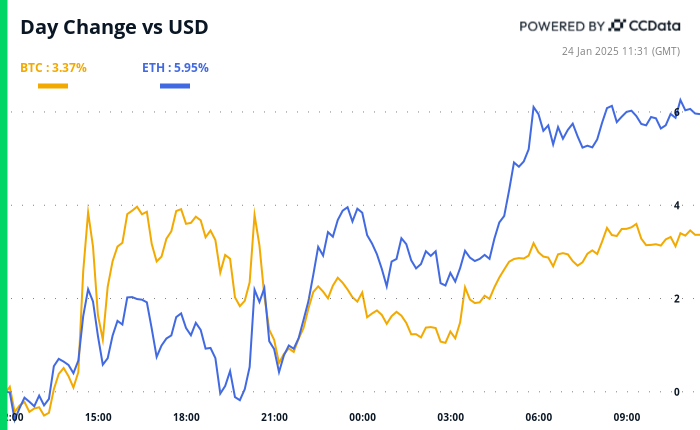
By James Van Straten (All times ET unless indicated otherwise)
The past 24 hours have been among the most hectic in the crypto industry for years, and this was reflected in Thursday’s bitcoin (BTC) price, which whipsawed 2% to 3% multiple times in a matter of minutes. Still, it managed to stay above the psychological $100,000 level and is is currently around $105,000.
President Trump’s rhetoric is continuing to help weaken the dollar, which generally boosts risk assets such as cryptocurrencies. The DXY index, a measure of the U.S. currency against a basket of major trade partners, has dropped to the lowest since Dec. 17, so that should give risk-on assets a feel-good boost. U.S. bond yields and WTI crude oil are also heading down, with oil below $75 a barrel, the lowest in two weeks.
On the other side of the world, the Bank of Japan (BoJ) delivered on its promise with another interest-rate increase, taking the policy rate to 0.50%, the highest in more than 16 years. That followed a very hot inflation print, with headline inflation of 3.6% from the previous year, the fastest since January 2023. The question is whether we will get a second iteration of the yen carry trade unwind that occurred in August of last year. Time will tell. Stay alert!
What to Watch
Crypto:
Jan. 25: First deadline for SEC decisions on proposals for four spot solana ETFs: Bitwise Solana ETF, Canary Solana ETF, 21Shares Core Solana ETF and VanEck Solana Trust, which are all sponsored by Cboe BZX Exchange.
Jan. 29: Ice Open Network (ION) mainnet launch.
Feb. 4: MicroStrategy Inc. (MSTR) Q4 FY 2024 earnings report.
Feb. 4: Pepecoin (PEPE) halving. At block 400,000, the reward will drop to 31,250 pepecoin.
Feb. 5, 3:00 p.m.: Boba Network’s Holocene hard fork network upgrade for its Ethereum-based L2 mainnet.
Macro
Jan. 24, 4:00 a.m.: S&P Global releases January 2025 eurozone HCOB Purchasing Managers’ Index (Flash) reports.
Composite PMI Est. 49.7 vs. Prev. 49.6.
Manufacturing PMI Est. 45.3 vs. Prev. 45.1.
Services PMI Est. 51.5 vs. Prev. 51.6.
Jan. 24, 4:30 a.m.: S&P Global releases January 2025’s U.K. Purchasing Managers’ Index (Flash) reports.
Composite PMI Est. 50 vs. Prev. 50.4.
Manufacturing PMI Est. 47 vs. Prev. 47.
Services PMI Est. 50.9 vs. Prev. 51.1.
Jan. 24, 9:45 a.m.: S&P Global releases January 2025’s U.S. Purchasing Managers’ Index (Flash) reports.
Composite PMI Prev. 55.4.
Manufacturing PMI Est. 49.6 vs. Prev. 49.4.
Services PMI Est. 56.5 vs. Prev. 56.8.
Jan. 24, 10:00 a.m.: The University of Michigan releases January U.S. consumer sentiment data.
Index of Consumer Sentiment (Final) Est. 73.2 vs. Prev. 74.
Token Events
Governance votes & calls
Frax DAO is discussing a $5 million investment in World Liberty Financial (WLFI), the crypto project backed by the family of President Donald Trump.
Jan. 24: Arbitrum BoLD’s activation vote deadline. BoLD allows anyone to participate in validation and defend against malicious claims to an Arbitrum chain’s state.
Jan. 24: Hedera (HBAR) is hosting a community call at 11 a.m.
Unlocks
Jan. 31: Optimism (OP) to unlock 2.32% of circulating supply worth $52.9 million.
Jan. 31: Jupiter (JUP) to unlock 41.5% of circulating supply worth $626 million.
Conferences:
Day 12 of 12: Swiss WEB3FEST Winter Edition 2025 (Zug, Zurich, St. Moritz, Davos)
Day 5 of 5: World Economic Forum Annual Meeting (Davos-Klosters, Switzerland)
Day 1 of 2: Adopting Bitcoin (Cape Town, South Africa)
Jan. 25-26: Catstanbul 2025 (Istanbul). The first community conference for Jupiter, a decentralized exchange (DEX) aggregator built on Solana.
Jan. 30, 12:30 p.m. to 5:00 p.m.: International DeFi Day 2025 (online)
Jan 30-31: Plan B Forum (San Salvador, El Salvador)
Jan. 30 to Feb. 4: The Satoshi Roundtable (Dubai)
Feb. 3: Digital Assets Forum (London)
Feb. 5-6: The 14th Global Blockchain Congress (Dubai)
Feb. 6: Ondo Summit 2025 (New York).
Feb. 7: Solana APEX (Mexico City)
Feb. 13-14: The 4th Edition of NFT Paris.
Feb. 18-20: Consensus Hong Kong
Feb. 19: Sui Connect: Hong Kong
Feb. 23 to March 2: ETHDenver 2025 (Denver)
Feb. 25: HederaCon 2025 (Denver)
Token Talk
By Shaurya Malwa
A humorous new decentralized autonomous organization, FartStrategy (FSTR) DAO, is investing user funds into FARTCOIN.
The DAO is leveraging borrowed SOL to acquire the token, offering investors a chance to gain exposure to its price movements through FSTR.
If FSTR trades below its FARTCOIN backing, token holders can vote to dissolve the DAO, redeeming their share of FARTCOIN proportionally after settling any outstanding debts.
The VINE memecoin jumped to a $200 million market capitalization less than 48 hours after issuance.
It was launched on the Solana blockchain by Rus Yusupov, one of the co-founders of the original Vine app, and introduced as a nostalgic tribute to the eponymous platform known for its six-second looping videos. Vine was a significant cultural phenomenon before closing in 2017.
There have been recent discussions around potentially reviving the app, with Yusupov and technocrat Elon Musk expressing interest in its return.
Derivatives Positioning
TRX leads growth in perpetual futures open interest in major coins.
Funding rates for majors remain below an annualized 10%, a sign the market isn’t overly speculative despite BTC trading near record highs on optimism about Trump’s crypto policies.
BTC and ETH call skews have firmed up, with block flows featuring outright longs in higher strike BTC calls and a bull call spread in ETH, involving calls at strikes $5K and $6K.
Market Movements:
BTC is up 2 % from 4 p.m. ET Thursday to $105,450.57 (24hrs: +3.43%)
ETH is up 4.96% at $3,409.62 (24hrs: +6.18%)
CoinDesk 20 is up 2.4% to 3,988.16 (24hrs: +4.79%)
CESR Composite Staking Rate is up 1 bp to 3.16%
BTC funding rate is at 0.0069% (7.58% annualized) on Binance
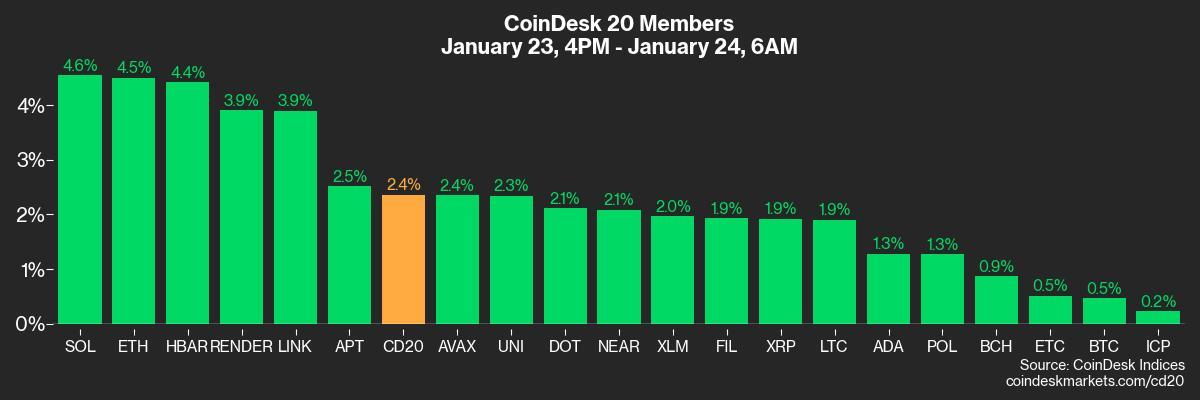
DXY is down 0.48% at 107.53
Gold is up 0.68% at $2,775.28/oz
Silver is up 1.21% to $30.86/oz
Nikkei 225 closed unchanged at 39,931.98
Hang Seng closed +1.86% to 20,066.19
FTSE is down 0.33% at 8,537.12
Euro Stoxx 50 is up 0.73% at 5,255.47
DJIA closed on Thursday +0.92% to 44,565.07
S&P 500 closed +0.53 at 6,118.71
Nasdaq closed +0.22% at 20,053.68
S&P/TSX Composite Index closed +0.48% at 25,434.08
S&P 40 Latin America closed +0.57% at 2,310.35
U.S. 10-year Treasury was down 13 bps at 4.64%
E-mini S&P 500 futures are down 0.13% at 6,143.75
E-mini Nasdaq-100 futures are down 0.56% at 22,005.50
E-mini Dow Jones Industrial Average Index futures are unchanged at 44,709.00
Bitcoin Stats:
BTC Dominance: 58.51 (-0.11%)
Ethereum to bitcoin ratio: 0.032 (0.68%)
Hashrate (seven-day moving average): 784 EH/s
Hashprice (spot): $61.0
Total Fees: 6.8 BTC/ $104,070
CME Futures Open Interest: 191,645
BTC priced in gold: 38.1 oz
BTC vs gold market cap: 10.83%
Technical Analysis
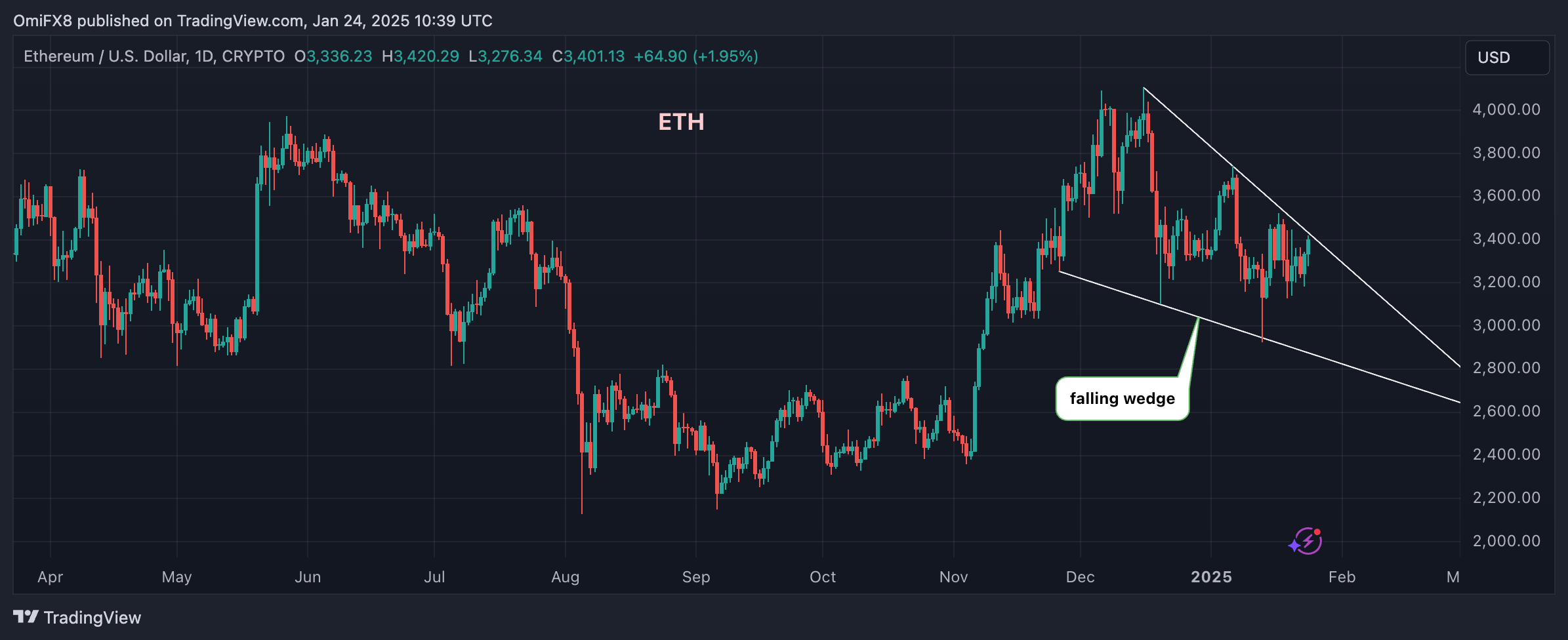
Ether seems have chalked out a falling wedge pattern, characterized by two converging trendlines, representing a series of lower highs and lower lows.
The converging nature of trendlines indicates that sellers are slowly losing grip.
A breakout is said to represent a bullish trend reversal.
Crypto Equities
MicroStrategy (MSTR): closed on Thursday at $373.12 (-1.11%), up 2.55% at $382.62 in pre-market.
Coinbase Global (COIN): closed at $296.01 (+0.05%), up 2.16% at $302.39 in pre-market.
Galaxy Digital Holdings (GLXY): closed at C$33.94 (+3.44%)
MARA Holdings (MARA): closed at $19.95 (+1.32%), up 1.8% at $20.31 in pre-market.
Riot Platforms (RIOT): closed at $12.99 (-1.14%), up 2.62% at $13.33 in pre-market.
Core Scientific (CORZ): closed at $16.34 (+2.32%), up 1.04% at $16.51 in pre-market.
CleanSpark (CLSK): closed at $11.41 (+2.42%), up 2.19% at $11.67 in pre-market.
CoinShares Valkyrie Bitcoin Miners ETF (WGMI): closed at $25.65 (+0.47%), up 1.75% at $26.10 in pre-market.
Semler Scientific (SMLR): closed at $61.15 (-1.55%), down 10.89% at $54.49 in pre-market.
Exodus Movement (EXOD): closed at $44 (+7.32%), up 0.75% at $44.33 in pre-market.
ETF Flows
Spot BTC ETFs:
Daily net flow: $188.7 million
Cumulative net flows: $39.42 billion
Total BTC holdings ~ 1.169 million.
Spot ETH ETFs
Daily net flow: -$14.9 million
Cumulative net flows: $2.79 billion
Total ETH holdings ~ 3.663 million.
Source: Farside Investors
Overnight Flows
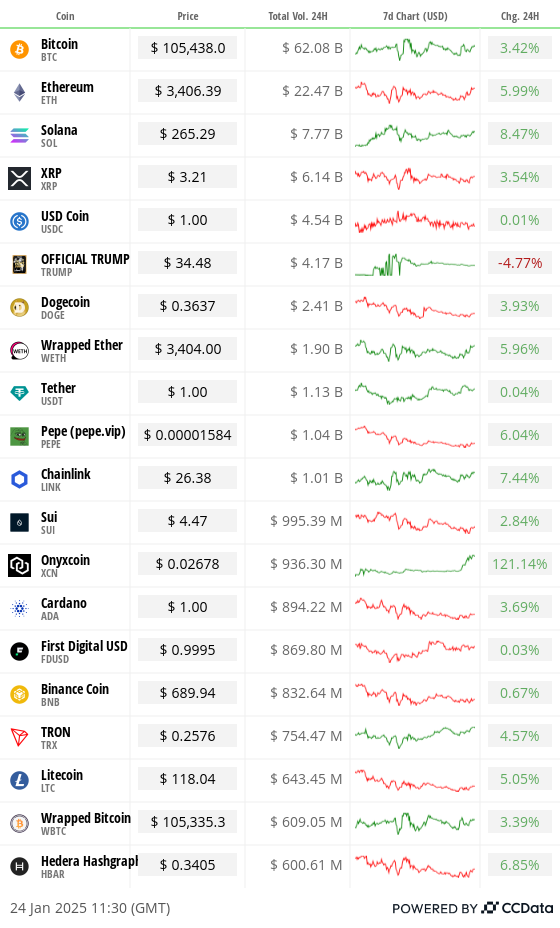
Chart of the Day
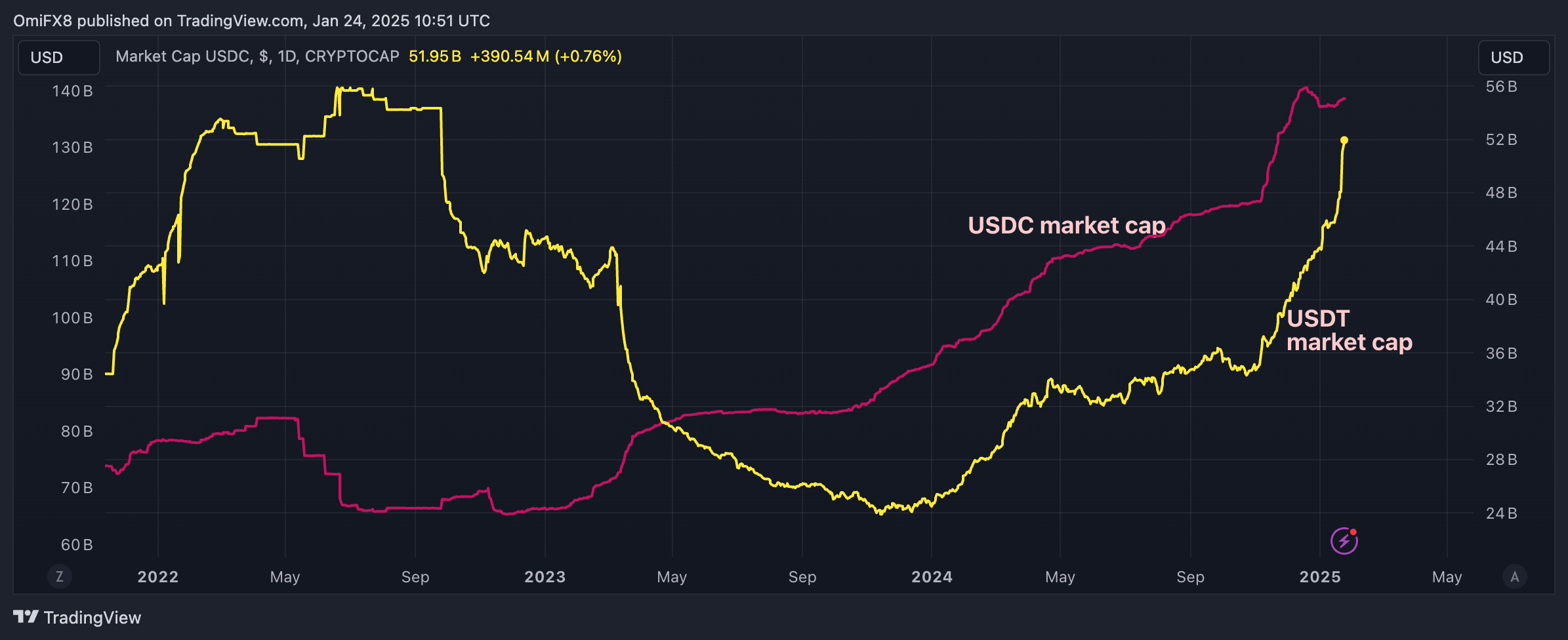
The market capitalization of Tether’s USDT, the world’s largest dollar-pegged stablecoin, has flattened near $138 billion.
The USDC supply continues to increase and has risen to nearly $52 billion this week, the highest since September 2022.
While You Were Sleeping
Bitcoin Steady Near $104K After Bank of Japan Delivers Hawkish Rate Hike (CoinDesk): Bitcoin held steady above $104,000 in early Asian hours Friday despite the Bank of Japan’s rate hike as markets eyed President Trump’s Thursday executive order on crypto and potential U.S. policy changes.
Trump Issues Crypto Executive Order to Pave U.S. Digital Assets Path (CoinDesk): President Trump issued a pro-crypto executive order, directing the creation of a digital asset framework, banning CBDC development and considering a national digital asset reserve.
Vitalik Buterin Calls for Added Focus on Ether as Part of the Network’s Scaling Plans (CoinDesk): In a Thursday post, Ethereum co-founder Vitalik Buterin outlined strategies to boost the value of ether including using it as collateral, implementing fee-burning incentives and increasing temporary transaction data called blobs.
Japan Hikes Rates, Solidifying Exit From Rock-Bottom Borrowing Costs (Bloomberg): The Bank of Japan raised its key rate by 25 basis points to 0.5% on Friday, the highest in 17 years, strengthening the yen and lifting 10-year bond yields to 1.23%.
U.S. Stocks at Most Expensive Relative to Bonds Since Dotcom Era (Financial Times): Stocks in the S&P 500 hit record valuations, with the equity risk premium turning negative for the first time since 2002 driven by soaring demand for dominant tech companies.
Trump 2.0 Is Going Well for China So Far. Can the Honeymoon Last? (CNN): In a Thursday interview, President Trump called tariffs a “tremendous power” but suggested deals could avert tougher measures. Beijing cautiously welcomed the reprieve, eyeing negotiations while bracing for future tensions.
In the Ether
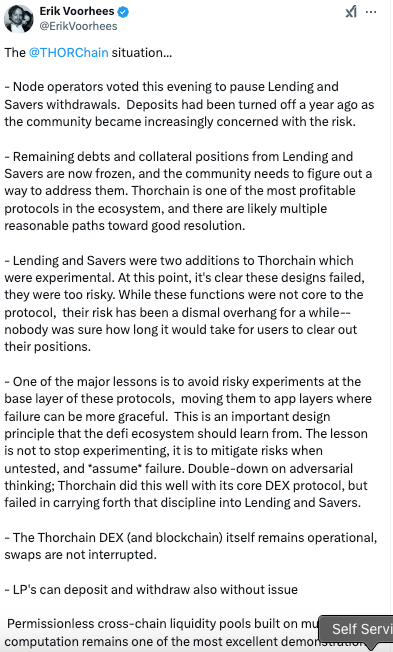
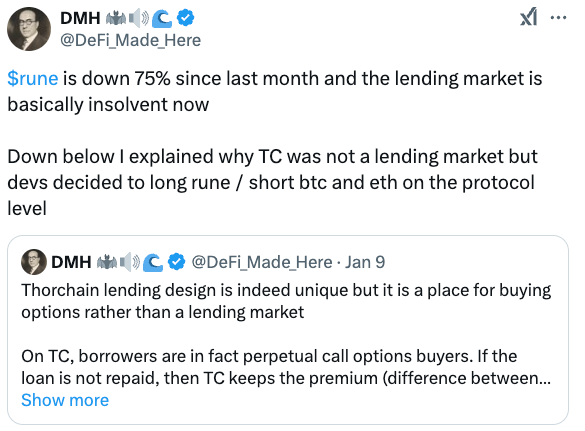
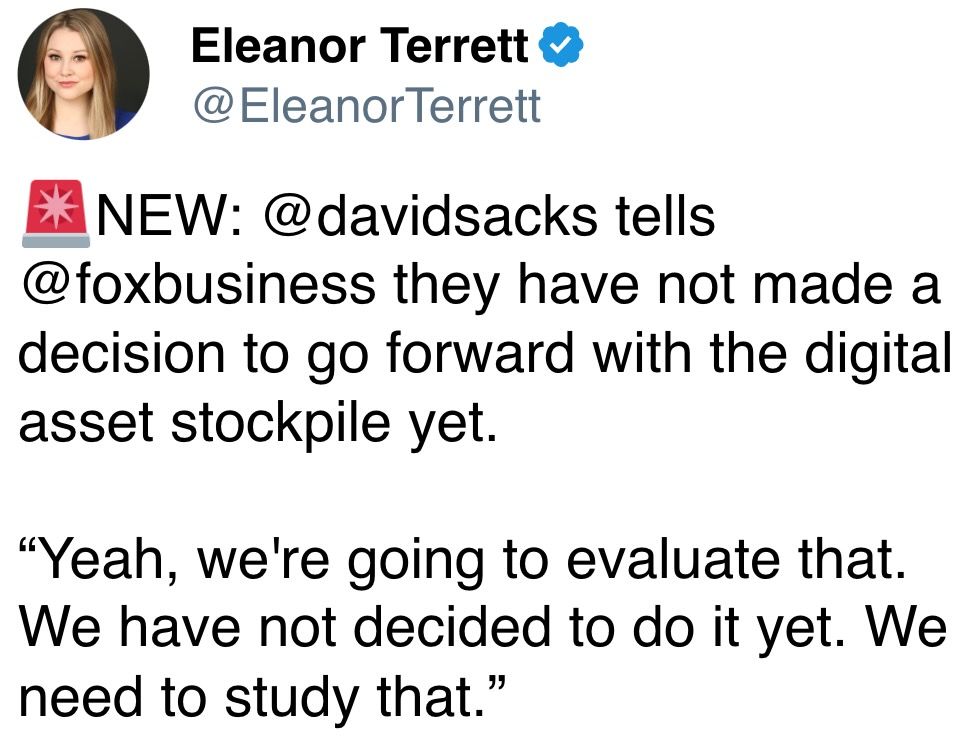
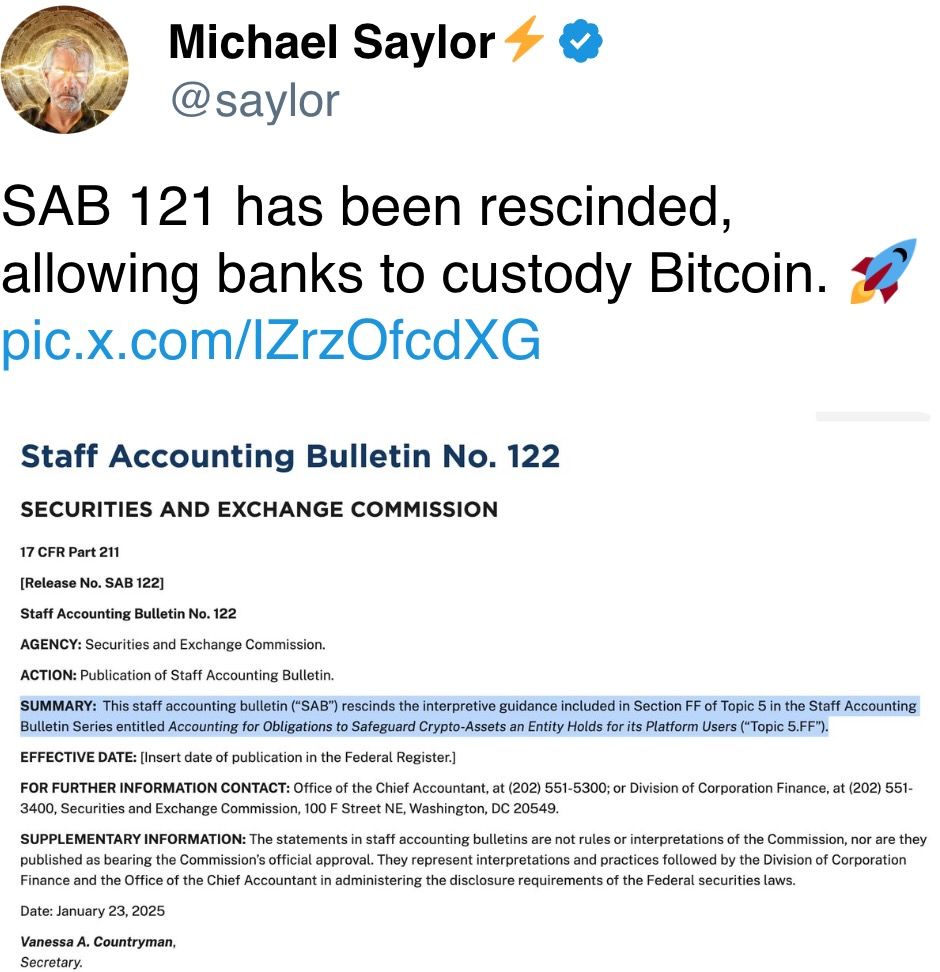
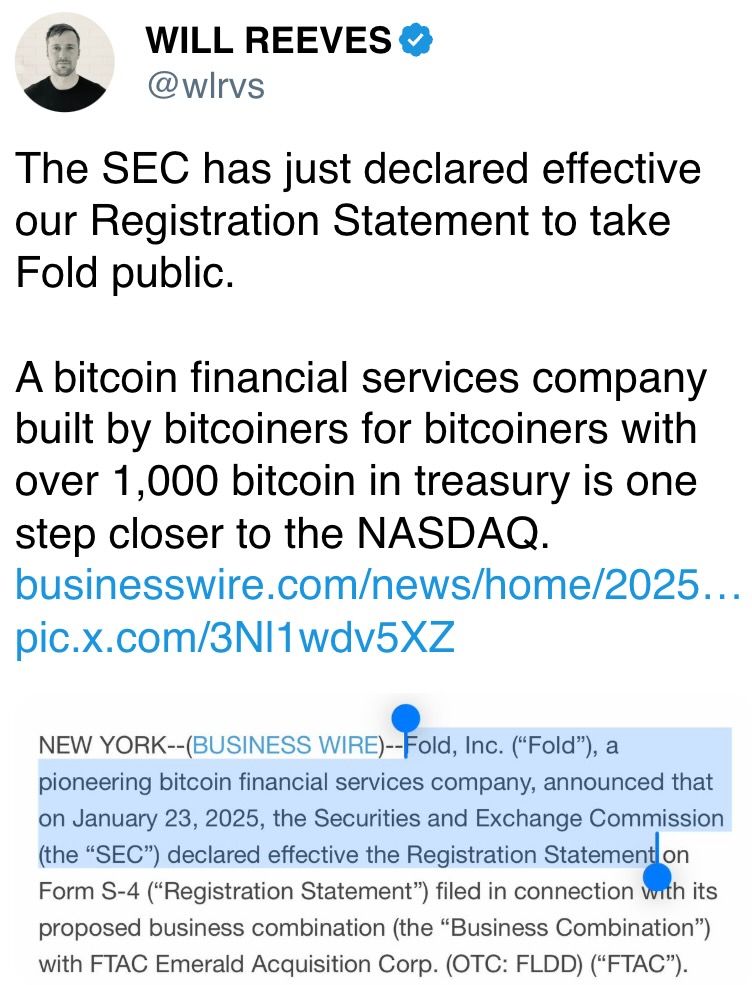

Business
AAVE Sees 64% Flash Crash as DeFi Protocol Endures ‘Largest Stress Test’
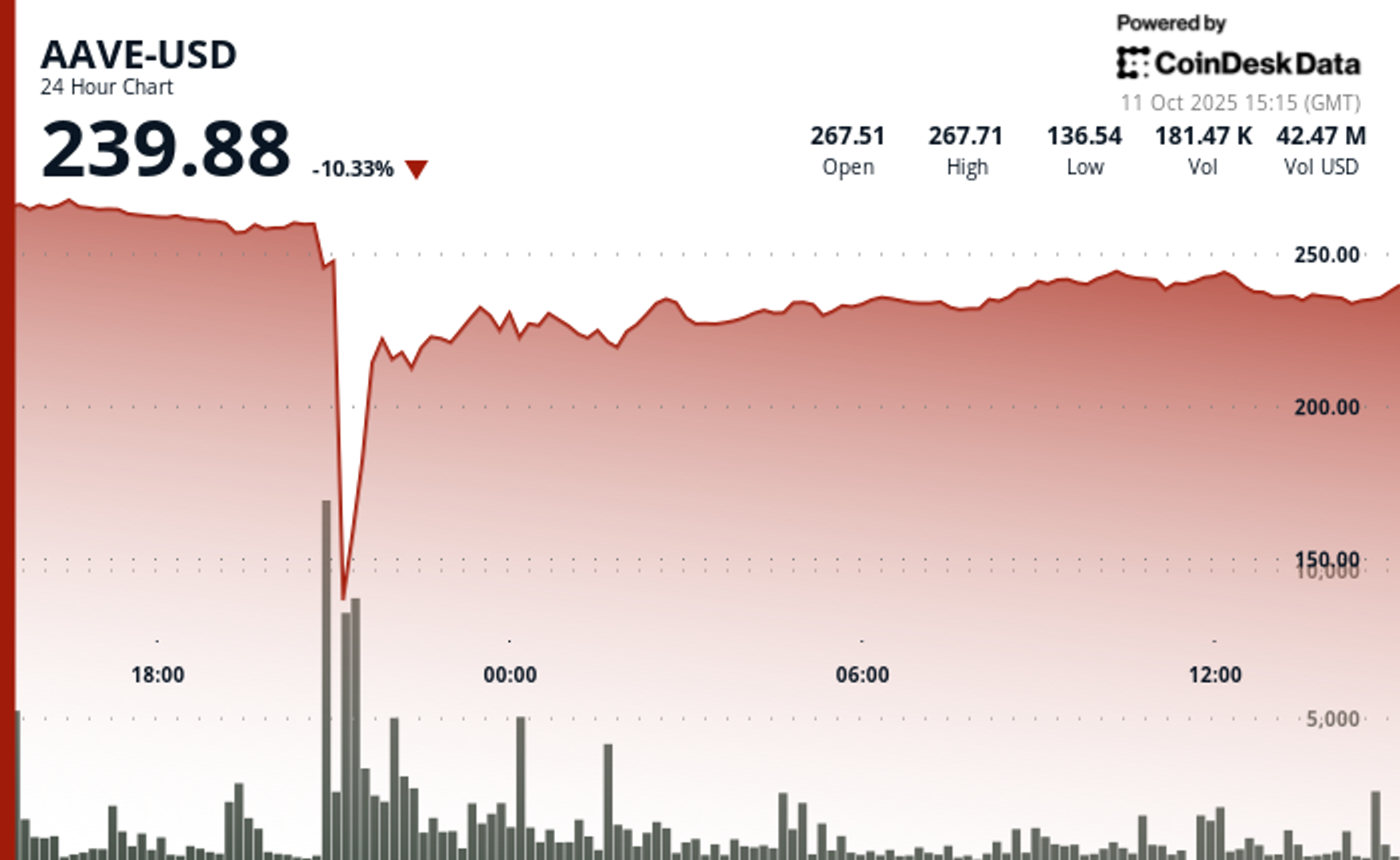
The native token of Aave (AAVE), the largest decentralized crypto lending protocol, was caught in the middle of Friday’s crypto flash crash while the protocol proved resilient in a historic liquidation cascade.
The token, trading at around $270 earlier in Friday, nosedived as much as 64% later in the session to touch $100, the lowest level in 14 months. It then staged a rapid rebound to near $240, still down 10% over the past 24 hours.
Stani Kulechov, founder of Aave, described Friday’s event as the «largest stress test» ever for the protocol and its $75 billion lending infrastructure.
The platform enables investors to lend and borrow digital assets without conventional intermediaries, using innovative mechanisms such as flash loans. Despite the extreme volatility, Aave’s performance underscores the evolving maturity and resilience of DeFi markets.
«The protocol operated flawlessly, automatically liquidating a record $180M worth of collateral in just one hour, without any human intervention,» Kulechov said in a Friday X post. «Once again, Aave has proven its resilience.»
Key price action:
- AAVE sustained a dramatic flash crash on Friday, declining 64% from $278.27 to $100.18 before recuperating to $240.09.
- The DeFi protocol demonstrated remarkable resilience with its native token’s 140% recovery from the intraday lows, underpinned by substantial trading volume of 570,838 units.
- Following the volatility, AAVE entered consolidation territory within a narrow $237.71-$242.80 range as markets digested the dramatic price action.
Technical Indicators Summary
- Price range of $179.12 representing 64% volatility during the 24-hour period.
- Volume surged to 570,838 units, substantially exceeding the 175,000 average.
- Near-term resistance identified at $242.80 capping rebound during consolidation phase.
Disclaimer: Parts of this article were generated with the assistance from AI tools and reviewed by our editorial team to ensure accuracy and adherence to our standards. For more information, see CoinDesk’s full AI Policy.
Business
Blockchain Will Drive the Agent-to-Agent AI Marketplace Boom

AI agents, software systems that use AI to pursue goals and complete tasks on behalf of users, are proliferating. Think of them as digital assistants that can make decisions and take actions towards goals you set without needing step-by-step instructions — from GPT-powered calendar managers to trading bots, the number of use cases is expanding rapidly. As their role expands across the economy, we have to build the right infrastructure that will allow these agents to communicate, collaborate and trade with one another in an open marketplace.
Big tech players like Google and AWS are building early marketplaces and commerce protocols, but that raises the question: will they aim to extract massive rents through walled gardens once more? Agents’ capabilities are clearly rising, almost daily, with the arrival of new models and architectures. What’s at risk is whether these agents will be truly autonomous.
Autonomous agents are valuable because they unlock a novel user experience: a shift from software as passive or reactive tools to active and even proactive partners. Instead of waiting for instructions, they can anticipate needs, adapt to changing conditions, and coordinate with other systems in real time, without the user’s constant input or presence. This autonomy in decision-making makes them uniquely suited for a world where speed and complexity outpace human decision-making.
Naturally, some worry about what greater decision-making autonomy means for work and accountability — but I see it as an opportunity. When agents handle repetitive, time-intensive tasks and parallelize what previously had to be done in sequence, they expand our productive capacity as humans — freeing people to engage in work that demands creativity, judgment, composition and meaningful connection. This isn’t make-believe, humanity has been there before: the arrival of corporations allowed entrepreneurs to create entirely new products and levels of wealth previously unthought of. AI agents have the potential to bring that capability to everyone.
On the intelligence side, truly autonomous decision-making requires AI agent infrastructure that is open source and transparent. OpenAI’s recent OSS release is a good step. Chinese labs, such as DeepSeek (DeepSeek), Moonshot AI (Kimi K2) and Alibaba (Qwen 3), have moved even quicker.
However, autonomy is not purely tied to intelligence and decision making. Without resources, an AI agent has little means to enact change in the real world. Hence, for agents to be truly autonomous they need to have access to resources and self-custody their assets. Programmable, permissionless, and composable blockchains are the ideal substrate for agents to do so.
Picture two scenarios. One where AI agents operate within a Web 2 platform like AWS or Google. They exist within the limited parameters set by these platforms in what is essentially a closed and permissioned environment. Now imagine a decentralized marketplace that spans many blockchain ecosystems. Developers can compose different sets of environments and parameters, therefore, the scope available to AI agents to operate is unlimited, accessible globally, and can evolve over time. One scenario looks like a toy idea of a marketplace, and the other is an actual global economy.
In other words, to truly scale not just AI agent adoption, but agent-to-agent commerce, we need rails that only blockchains can offer.
The Limits of Centralized Marketplaces
AWS recently announced an agent-to-agent marketplace aimed at addressing the growing demand for ready-made agents. But their approach inherits the same inefficiencies and limitations that have long plagued siloed systems. Agents must wait for human verification, rely on closed APIs and operate in environments where transparency is optional, if it exists at all.
To act autonomously and at scale, agents can’t be boxed into closed ecosystems that restrict functionality, pose platform risks, impose opaque fees, or make it impossible to verify what actions were taken and why.
Decentralization Scales Agent Systems
An open ecosystem allows for agents to act on behalf of users, coordinate with other agents, and operate across services without permissioned barriers.
Blockchains already offer the key tools needed. Smart contracts allow agents to perform tasks automatically, with rules embedded in code, while stablecoins and tokens enable instant, global value transfers without payment friction. Smart accounts, which are programmable blockchain wallets like Safe, allow users to restrict agents in their activity and scope (via guards). For instance, an agent may only be allowed to use whitelisted protocols. These tools allow AI agents not only to behave expansively but also to be contained within risk parameters defined by the end user. For example, this could be setting spending limits, requiring multi-signatures for approvals, or restricting agents to whitelisted protocols.
Blockchain also provides the transparency needed so users can audit agent decisions, even when they aren’t directly involved. At the same time, this doesn’t mean that all agent-to-agent interactions need to happen onchain. E.g. AI agents can use offchain APIs with access constraints defined and payments executed onchain.
In short, decentralized infrastructure gives agents the tools to operate more freely and efficiently than closed systems allow.
It’s Already Happening Onchain
While centralized players are still refining their agent strategies, blockchain is already enabling early forms of agent-to-agent interaction. Onchain agents are already exhibiting more advanced behavior like purchasing predictions and data from other agents. And as more open frameworks emerge, developers are building agents that can access services, make payments, and even subscribe to other agents — all without human involvement.
Protocols are already implementing the next step: monetization. With open marketplaces, people and businesses are able to rent agents, earn from specialized ones, and build new services that plug directly into this agent economy. Customisation of payment models such as subscription, one-off payments, or bundled packages will also be key in facilitating different user needs. This will unlock an entirely new model of economic participation.
Why This Distinction Matters
Without open systems, fragmentation breaks the promise of seamless AI support. An agent can easily bring tasks to completion if it stays within an individual ecosystem, like coordinating between different Google apps. However, where third-party platforms are necessary (across social, travel, finance, etc), an open onchain marketplace will allow agents to programmatically acquire the various services and goods they need to complete a user’s request.
Decentralized systems avoid these limitations. Users can own, modify, and deploy agents tailored to their needs without relying on vendor-controlled environments.
We’ve already seen this work in DeFi, with DeFi legos. Bots automate lending strategies, manage positions, and rebalance portfolios, sometimes better than any human could. Now, that same approach is being applied as “agent legos” across sectors including logistics, gaming, customer support, and more.
The Path Forward
The agent economy is growing fast. What we build now will shape how it functions and for whom it works. If we rely solely on centralized systems, we risk creating another generation of AI tools that feel useful but ultimately serve the platform, not the person.
Blockchain changes that. It enables systems where agents act on your behalf, earn on your ideas, and plug into a broader, open marketplace.
If we want agents that collaborate, transact, and evolve without constraint, then the future of agent-to-agent marketplaces must live onchain.
Business
‘Largest Ever’ Crypto Liquidation Event Wipes Out 6,300 Wallets on Hyperliquid

More than 1,000 wallets on Hyperliquid were completely liquidated during the recent violent crypto sell-off, which erased over $1.23 billion in trader capital on the platform, according to data from its leaderboard.
In total, 6,300 wallets are now in the red, with 205 losing over $1 million each according to the data, which was first spotted by Lookonchain. More than 1,000 accounts saw losses of at least $100,000.
The wipeout came as crypto markets reeled from a global risk-off event triggered by U.S. President Donald Trump’s announcement of a 100% additional tariff on Chinese imports.
The move spooked investors across asset classes and sent cryptocurrency prices tumbling. Bitcoin briefly dropped below $110,000 and ether fell under $3,700, while the broader market as measured by the CoinDesk 20 (CD20) index dropped by 15% at one point.
The broad sell-off led to over $19 billion in liquidations over a 24 hours period, making it the largest single-day liquidation event in crypto history by dollar value. According to CoinGlass, the “actual total” of liquidations is “likely much higher” as leading crypto exchange Binance doesn’t report as quickly as other platforms.
Leaderboard data reviewed by CoinDesk shows the top 100 traders on Hyperliquid gained $1.69 billion collectively.
In comparison, the top 100 losers dropped $743.5 million, leaving a net profit of $951 million concentrated among a handful of highly leveraged short sellers.
The biggest winner was wallet 0x5273…065f, which made over $700 million from short positions, while the largest loser, “TheWhiteWhale,” dropped $62.5 million.
Among the victims of the flush is crypto personality Jeffrey Huang, known online as Machi Big Brother, who once launched a defamation suit against ZachXBT, losing almost the entire value of his wallet, amounting to $14 million.
«Was fun while it lasted,» he posted on X.
Adding to the uncertainty, the ongoing U.S. government shutdown has delayed the release of key economic data. Without official indicators, markets are flying blind at a time when geopolitical risk is rising.
-

 Business12 месяцев ago
Business12 месяцев ago3 Ways to make your business presentation more relatable
-

 Fashion12 месяцев ago
Fashion12 месяцев agoAccording to Dior Couture, this taboo fashion accessory is back
-

 Entertainment12 месяцев ago
Entertainment12 месяцев ago10 Artists who retired from music and made a comeback
-

 Entertainment12 месяцев ago
Entertainment12 месяцев ago\’Better Call Saul\’ has been renewed for a fourth season
-

 Entertainment12 месяцев ago
Entertainment12 месяцев agoNew Season 8 Walking Dead trailer flashes forward in time
-

 Business12 месяцев ago
Business12 месяцев ago15 Habits that could be hurting your business relationships
-

 Entertainment12 месяцев ago
Entertainment12 месяцев agoMeet Superman\’s grandfather in new trailer for Krypton
-

 Entertainment12 месяцев ago
Entertainment12 месяцев agoDisney\’s live-action Aladdin finally finds its stars





